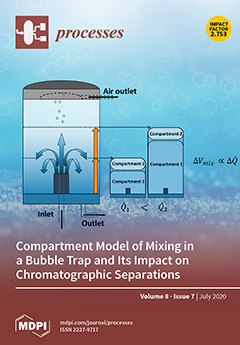In this study, there is 1.42% P
2O
5 in the P-containing V-Ti magnetite tailings in Miyi Region of China, with the valuable minerals mainly including apatite, and aluminosilicate minerals as the main gangue components. The direction flotation process was used to
[...] Read more.
In this study, there is 1.42% P
2O
5 in the P-containing V-Ti magnetite tailings in Miyi Region of China, with the valuable minerals mainly including apatite, and aluminosilicate minerals as the main gangue components. The direction flotation process was used to recover phosphorous from the low-grade phosphorous-bearing V-Ti magnetite tailings. The results showed that an optimized phosphorous concentrate with a P
2O
5 grade of 31.35% and P
2O
5 recovery of 88.02% was obtained by flotation process of one roughing, three scavengings, and three cleanings under roughing conditions, which employed pulp pH of 9, grinding fineness of <0.039 mm occupying 90%, flotation concentration of 25%, and dosages of carboxymethylcellulose, oxidized paraffin wax soap, and pine oil of 400 g/t, 300 g/t, and 20 g/t, respectively. Optimized one scavenging, two scavenging, and three scavenging conditions used a pulp pH of 9, and dosages of carboxymethylcellulose, oxidized paraffin wax soap, and pine oil of 200 g/t, 150 g/t, 10 g/t; 100 g/t, 75 g/t, and 5 g/t; and 100 g/t, 75 g/t, and 5 g/t, respectively. Optimized one cleaning, two cleaning, and three cleaning condition dosages of carboxymethylcellulose of 100 g/t, 50 g/t, and 25 g/t, respectively. Study of analysis and characterization of phosphorous concentrate by X-ray diffraction (XRD), scanning electron microscopy (SEM), and energy dispersive spectroscopy (EDS) show that most gangue minerals enter the flotation tailings, the main minerals in phosphorous concentrate are apatite, olivine, and feldspar.
Full article





